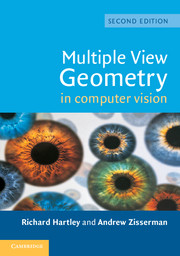Book contents
- Frontmatter
- Contents
- Foreword
- Preface
- 1 Introduction – a Tour of Multiple View Geometry
- PART 0 The Background: Projective Geometry, Transformations and Estimation
- PART I Camera Geometry and Single View Geometry
- PART II Two-View Geometry
- PART III Three-View Geometry
- PART IV N-View Geometry
- PART V Appendices
- Bibliography
- Index
PART III - Three-View Geometry
Published online by Cambridge University Press: 25 January 2011
- Frontmatter
- Contents
- Foreword
- Preface
- 1 Introduction – a Tour of Multiple View Geometry
- PART 0 The Background: Projective Geometry, Transformations and Estimation
- PART I Camera Geometry and Single View Geometry
- PART II Two-View Geometry
- PART III Three-View Geometry
- PART IV N-View Geometry
- PART V Appendices
- Bibliography
- Index
Summary
Outline
This part contains two chapters on the geometry of three-views. The scene is imaged with three cameras perhaps simultaneously in a trinocular rig, or sequentially from a moving camera.
Chapter 15 introduces a new multiple view object – the trifocal tensor. This has analogous properties to the fundamental matrix of two-view geometry: it is independent of scene structure depending only on the (projective) relations between the cameras. The camera matrices may be retrieved from the trifocal tensor up to a common projective transformation of 3-space, and the fundamental matrices for view-pairs may be retrieved uniquely.
The new geometry compared with the two-view case is the ability to transfer from two views to a third: given a point correspondence over two views the position of the point in the third view is determined; and similarly, given a line correspondence over two views the position of the line in the third view is determined. This transfer property is of great benefit when establishing correspondences over multiple views.
If the essence of the epipolar constraint over two views is that rays back-projected from corresponding points are coplanar, then the essence of the trifocal constraint over three views is the geometry of a point–line–line correspondence arising from the image of a point on a line in 3-space: corresponding image lines in two views back-project to planes which intersect in a line in 3-space, and the ray back-projected from a corresponding image point in a third view must intersect this line.
Information
- Type
- Chapter
- Information
- Multiple View Geometry in Computer Vision , pp. 363 - 364Publisher: Cambridge University PressPrint publication year: 2004
